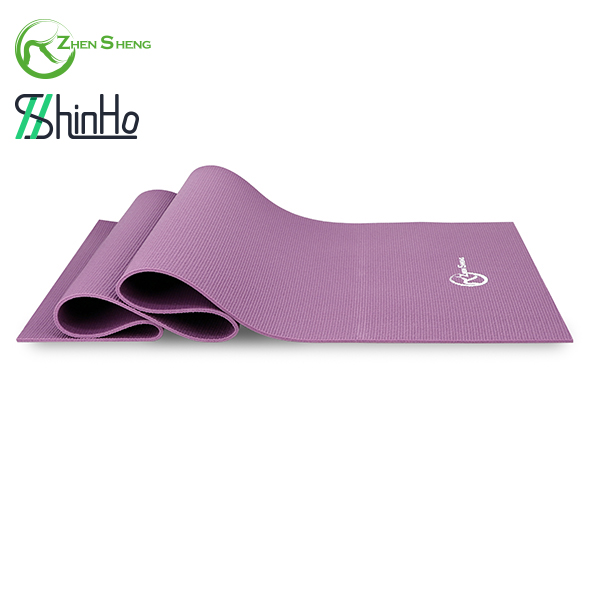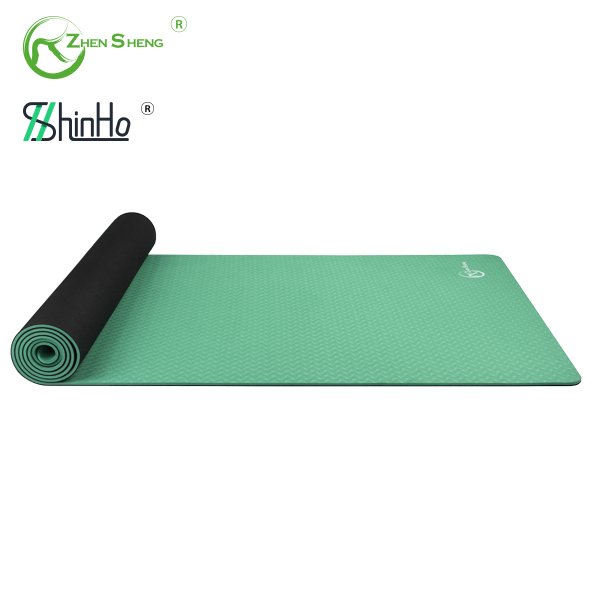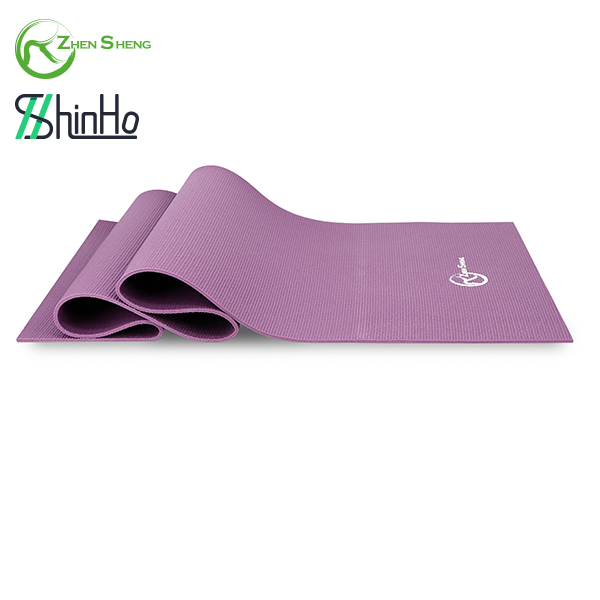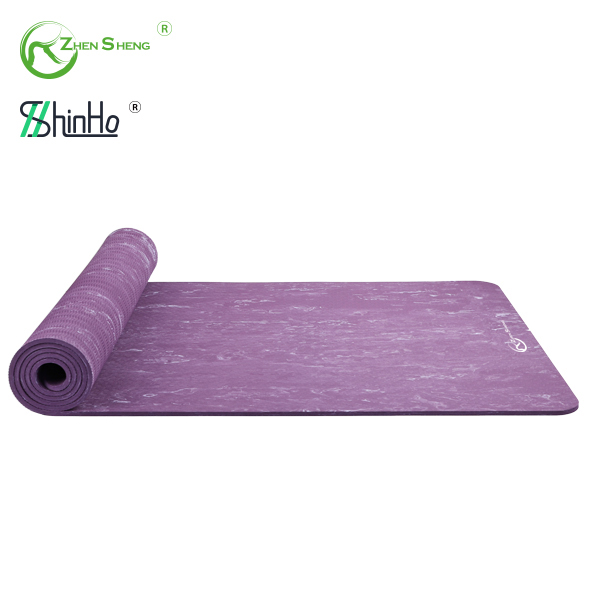How to choose the right yoga mat?
If you have any product customization needs or ideas, MOQ 500, contact us.
Jun. 16, 2022
Whether your client is new to yoga or a long-term enthusiast, buying our mats in bulk can make a world of difference to you and your client's experience. Sometimes it can be overwhelming to make the right choice using the vast array of mats available on the market.
Fifteen years ago, there was only one basic type of yoga mat - made of PVC and known for its sticky, non-slip nature - and your only choice was whether to buy purple or blue. Now, as the yoga market expands, yoga mats are available to suit every priority and preference.
As well to a color and pattern to suit the style, a yoga mat needs to keep the yogi in a stable position; it needs to be storable and portable, yet comfortable and cozy. The eco-friendly nature of the yoga mat is another plus point. These aspects of your mat's personality are influenced by the way the mat is made: how thick it is, what it is made of, and the texture of its surface.
Understanding the differences will help you choose the right mat for your customers' needs, find a yoga mat that better matches your customers' needs, highlight your product's features and develop your market - ready to get started!
The comfort level required on your mat depends first and foremost on the frequency of your training. The more often you train, the more comfortable you want - i.e. the thickness of the mat.
When you are an absolute beginner, grip and thickness are important. You may be practicing a gentle style of yoga such as Hatha, yin, restorative or prenatal yoga, which tends to focus on slower postures and contact with the floor, and you will want more comfort. You should choose a mat that is 5 to 8 mm thick to help protect your joints.
As your practice reaches an intermediate intensity, you will move into classes that will build muscle and make you sweat! As you transition to a more advanced level of gentle yoga, you can still use a 5 to 8 mm thick mat, but this time choose a better quality mat that can accommodate longer yoga sessions.
If you are doing dynamic yoga such as ashtanga, vinyasa, or a lot of standing poses that require good balance in a warm room (e.g. hot/hot yoga), then your priority is stability and enough grip to avoid slipping. Therefore, it is best to use a thinner mat with a maximum thickness of between 1 and 5 mm.
Why it's important: The thickness of your yoga mat has a lot to do with its comfort level - too thin and your knees could get banged up in a crescent lunge. The trade-off is that thicker mats (some up to 1/4 inch thick) will make it harder to feel a tight connection to the floor, for example, making you more wobbly in tree pose.
Options: Standard mats are about 1/8" thick, while the thickest is about 1/4". There are also extremely thin mats, often called 'travel mats', which are only 1/16th of an inch thick. They are easy to fold and not too heavy to carry in a suitcase.

Basic buying guide: Consider how much space you have for your mat, how important portability is, and whether your best position is to be comfortable or to feel a direct connection to the floor. If you are short on storage space, have a long leash on your studio, and prefer the feel of just a little padding, choose a standard depth mat in the 1/8" range.
If you don't mind carrying and storing more weight for cushioning, consider a quality yoga mat that is approximately 1/4 inch thick. If you absolutely must be able to fit your mat into a suitcase or carry it with you, get yourself a foldable travel yoga mat in the 1/16 inch range.
The size of your mat is also important for a comfortable workout.
Obviously, you need to consider your height when choosing a mat, but you also need to consider the activity you will be doing. If you are exercising where you are in regular contact with the floor, then you will need a longer mat than if you spend most of your time sitting or kneeling.
Importance: The material of your yoga mat determines its texture, stickiness, eco-friendliness and sponginess (how well it affects pressure), as well as how it wears over time.
Options: Most standard yoga mats are made from PVC, also known as vinyl. Newer, more environmentally friendly options include natural and recycled rubber, jute, organic cotton or natural cotton (this means the fabric is not treated with a synthetic finish in the manufacturing process).
PVC is a plastic-based material from which many mats are made. It is durable, cleanable and grippy. Please note that they do not absorb water, so they become very smooth when wet by the seat. It is also latex-free, so if you are allergic to latex, please consider it. However, it is not as biodegradable or environmentally friendly as other options.

TPE, or thermoplastic elastomer, is a man-made blend of plastic and rubber polymers. These mats are usually more environmentally friendly than PVC and some are even fully recyclable. You should note that these are usually not as durable as PVC, but they are still great in the traction department.

Eco or natural mats are made from materials such as natural rubber, cotton and jute. They usually have less grip on the floor, but they will provide enough traction for your hands and feet. They are not as durable as PVC, but if sustainability is a priority, they are worth it.

Basic buying guide: If you are allergic to latex, avoid yoga mats made from natural rubber. If you want to stick with a tried and tested true sticky mat, choose a yoga mat made from PVC that will withstand your use and abuse for over a decade. Sponginess varies greatly depending on the material mix, but in general, PVC is the most 'powerful' of all yoga mat materials; jute and cotton are the least.
Beyond these basics, read on and let your other priorities - texture, tackiness and eco-friendliness - be your guide.
Why it's important: The texture of your yoga mat determines the traction it provides. Like stickiness, texture affects how much you slide. It provides a physical barrier to sliding (whereas stickiness relies on suction). And because texture affects the feel of your yoga mat, it is also a component of overall comfort.
If you are the pea princess type, any uneven texture may exacerbate your mood in savasana. Textures can be artificial (such as a raised bump pattern) or determined by the material - jute yoga mats have an organic, rough feel, while PVC mats have a slight texture but a softer feel.
Options: Yoga mat textures suit every whim - from completely smooth to completely rough.
Basic buying guide: If you're looking for a yoga mat that prevents slipping and you want to avoid PVC mats (traditional sticky yoga mats), look for rubber, jute or cotton yoga mat patterns with a raised, tactile texture. The extra grip provided by the raised texture will help you stay still, no matter how sweaty or strenuous your practice is.
If smoothness is most important to you, then a PVC yoga mat is the way to go. If you like stickiness but are curious about newer, more eco-friendly options, test-drive them a few times before you buy. Some eco-friendly yoga mats may surprise you with the traction they offer, even if they don't have the traditional 'sticky' feel.
Why it's important: A sticky yoga mat prevents you from sliding all over the place and helps you maintain alignment as you move from pose to pose and hold the pose for a few seconds.
Options: PVC yoga mats have the highest stickiness factor.
Basic buying guide: If you need help holding a pose but the thought of practicing on a mat with a raised texture gives you the creeps, then a PVC yoga mat is probably your best bet. Remember, these mats only get sticky when cleaned, so make sure you take good care of your mat. If you buy a PVC mat, wash it before use and use a handy yoga cleaner if you find your hands sliding forward in downward dog.
Why it's important: As yogis, we hold dear the creed of ahimsa or non-violence. You may find that some of the more eco-friendly yoga product companies do include PVC in their materials, just not as much. PVC is difficult to recycle and its lifetime recyclability is limited. Eco-friendly companies that use PVC for yoga mats are very considerate and will take them back for recycling once the mat's life cycle is complete. Other companies that reuse materials that are difficult to recycle often use this method.
Options: Eco-friendly yoga mats are usually made of natural or recycled rubber. These mats may also include natural materials, such as jute or organic cotton. Also consider yoga mats made from sustainable cork, recycled natural tree rubber and other recycled materials when looking for an eco-friendly yoga mat. Avoid yoga mats that have been chemically treated.
Basic buying guide: If being environmentally friendly is important to you, avoid yoga mats made of PVC (traditional sticky mats), which do not decompose in landfills and are difficult and expensive to recycle. You can get eco-friendly yoga mats that are thick enough to meet your needs for comfort and portability and have textures (such as raised geometric patterns) that prevent sliding.
Typically, a basic 1/8-inch thick, solid-colored PVC sticky yoga mat will be at the lower end of the price range. From there you can pay more for patterns, designs or logos; premium thickness; anti-bacterial treatments; and cool textures, especially raised tactile patterns. Eco-friendly yoga mats tend to be at the higher end of the price range.
Once you've narrowed down your choices based on thickness, size, material, texture, tackiness, eco-friendliness and price, there's only one factor left: style! So go ahead and choose the color, pattern or print you like best. After all, you'll be seeing a lot of it in downward dog style. Happy shopping!
Take all you've learned and shop our entire range of yoga mats to find the perfect fit for you!
Search Blog
New Products
E-mail: planning@shzhensheng.com
Mob.: +86 138 0168 6978
Tel.: +86 21 5204 8758
Add.: Room 203, Building 1, No. 423 Wuning Road, Putuo district, Shanghai 200063, China
Navigation
Get in touch
seoKeywords: custom size yoga mat custom logo yoga mat custom Rubber Pilates Yoga Mat eco friendly rubber yoga mat custom Pilates Yoga Mat TPE Rubber Professional Yoga Mat rectangle yoga mat tpe comfortable tpe yoga mat comfortable tpe yoga mat Customize nbr yoga mat custom round yoga mat round yoga mats wholesale eco friendly yoga mats wholesale non slip yoga mat wholesale Customize non slip yoga mat wholesale ankle weights wholesale custom round yoga mat round yoga mats wholesale personalized soccer ball size 5 personalized soccer ball size 4 Thermo Bonded Football Machine Stitched Football custom resistance bands wholesale wholesale resistance bands with logo custom printed resistance bands custom logo resistance bands custom size resistance bands custom length resistance bands custom ankle weights ankle weights cost ankle weights cost buy ankle weights custom balance board surf balance board oem yoga mat yoga mat factory yoga mat manufacturer tpe yoga mat manufacturer private label yoga mats